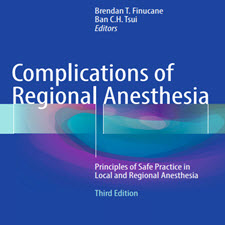بایگانی برچسب برای: Complications

Complications of Regional Anesthesia
اطلاع رسانیRegional anesthesia is defned as the selective blockade of a nerve or group of nerves supplying an area of the body such as a limb(s) or an eye, using local anesthetics, thereby allowing a surgeon to operate on a patient without the need for full general anesthesia. Local anesthesia is a non-selective blockade of a smaller area of the body by infltrating with local anesthesia directly into the skin, subcutaneous, and deeper tissues, without any attempt to target a particular nerve. Topical anesthesia refers to anesthesia of the skin or mucous membranes which occurs following topical application of a local anesthetic. A number of different approaches to regional anesthesia were tried before and after general anesthesia was introduced in 1846, but none of them were satisfactory. These included: nerve compression, refrigeration, alcohol injections, acupuncture, and ether sprays, but no real progress was made until the discovery of local anesthetics.
![Managing.Complications.in.Glaucoma.Surgery.[taliem.ir]](https://taliem.ir/wp-content/uploads/Managing.Complications.in_.Glaucoma.Surgery.taliem.ir_-1.jpg)
Managing Complications in Glaucoma Surgery
اطلاع رسانیArgon laser trabeculoplasty (ALT) was frst introduced in 1979 by Wise and Witter (Coakes 1992). Despite its clinical effcacy in intraocular pressure (IOP) lowering, its use is limited by scarring of the trabecular meshwork, which may potentially restrict retreatment. ALT is usually performed with topical anesthesia under direct visualization using a gonioscopic lens. Initially, only 180° of the meshwork is treated. Around 40–50 laser spots are aimed at the anterior half of the trabecular meshwork to reduce the chance of peripheral anterior synechiae (PAS) formation. The laser spot size is 50 μm and the initial laser energy of 800 mW is titrated until minimal bubble formation in the pigmented trabecular meshwork is seen. After 4–6 weeks, IOP is reassessed and the remaining half of the trabecular meshwork may be treated if needed. Topical steroids are usually given for the frst week after ALT (Weinreb and Wilensky 1984).
![Diabetes.and.Aging-related.[taliem.ir]](https://taliem.ir/wp-content/uploads/Diabetes.and_.Aging-related.taliem.ir_.jpg)
Diabetes and Aging-related Complications
اطلاع رسانیRenal senescence is accompanied by a gradual decrease in its function. Although it rarely causes clinical problems per se, superimposition of various diseases, such as diabetes, may accelerate this functional decline. Recent research has revealed some of the complex mechanisms of how diabetes promotes the aging process in the kidney, including the pathogenic roles of hemodynamic changes, tubulointerstitial hypoxia, oxidative stress, advanced glycation end-products, and impaired autophagy. Diabetes also modulates aging-related signaling pathways, such as sirtuins and mammalian target of rapamycin. Current therapeutic strategy for diabetic kidney disease consists of glycemic control and antihypertensive treatment with renin- angiotensin system inhibitors. However, they fail to fully prevent the progression of diabetic kidney disease, raising an urgent need for novel therapeutic methods. Some pharmacological agents are being developed based on the knowledge of hemodynamic and molecular basis of diabetes- and aging-related kidney function decline.
![Emergency Department...[taliem.ir]](https://taliem.ir/wp-content/uploads/Emergency-Department...taliem.ir_.jpg)
Emergency Department Management of Obstetric Complications
اطلاع رسانیPregnant patients often present to the emergency department (ED) with chief complaints of abdominal pain and/or vaginal bleeding in the frst trimester .Women presenting to the ED in early pregnancy may not be aware of their pregnancy status; it is critical that emergency clinicians test for pregnancy in any woman of childbearing age with abdominal pain or vaginal bleeding. Helpful historical clues include date of last menstrual period (LMP) and, for patients who are aware they are pregnant, whether or not they have had an ultrasound with this pregnancy. Complications such as pain and bleeding in early pregnancy are common. Indeed, one fourth of women will have vaginal bleeding or spotting in the frst few weeks of pregnancy, and one half of those patients will miscarry . Ultimately these patients will receive a diagnosis of threatened miscarriage, miscarriage, pregnancy of unknown location, ectopic pregnancy, or, rarely, heterotopic pregnancy. Some complications such as ectopic pregnancy may be life threatening; others are emotionally devastating and may impact future fertility. Emergency physicians must be prepared to evaluate and manage the various complications of early pregnancy.

